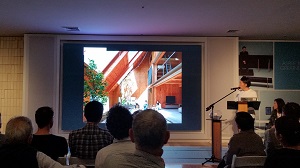In order to diversify students’ assignments, a professor may require doing unusual tasks, including seminar presentations. Thus, one may assume that it is somehow similar to making a regular presentation, although students still tend to wonder how to write a seminar presentation. In particular, this type of work includes an academic paper and a supportive visual presentation. What is more, it is crucial to not only gather information but also to make sure that the content is coherent and interesting to the audience. Therefore, while considering how to write a seminar presentation, it is essential to keep these points in mind.
 In order to show the best performance, a student has to realize that writing any academic work needs to be a well-planned process. Therefore, in the case of writing a seminar presentation, it is better to divide the activity into three stages:
In order to show the best performance, a student has to realize that writing any academic work needs to be a well-planned process. Therefore, in the case of writing a seminar presentation, it is better to divide the activity into three stages:
- preparation;
- writing and revising a draft;
- making illustrative slides.
Preparation
The very first task when writing a seminar presentation is to learn the requirements carefully and specify the unclear ones by consulting the teacher. Then, the actual work on the seminar presentation should start with deciding on the topic and its scope. The perfect topic is the one that is not too complex while it should not be a shallow one at the same time. Having done that, the next step is to state a research question that will be the central matter to focus the entire work on. In addition, revising the basic rules of academic writing will definitely appear beneficial. Thus, a seminar presentation includes a concise introduction to the topic, several sections that are clearly divided, and a summarizing conclusion, as well as supportive visual slides.
Writing and Revising a Draft
The next stage is to start the actual research. Thus, it is suggested to start with creating an approximate plan of the paper and a list of ideas to use while taking into account the amount of information that needs to be covered. The next step is to seek for useful references and look through them while taking notes. It is a necessity to remember to use sources that are relatively recent, preferably not older than 5 years.
As for the draft, the notes are to be used for making an outline that consists of several leading points. Then, it is possible to start including some background information to support the main ideas, along with adding an interesting opening statement and a good closing one. The last step is to make the information pleasantly flow by adding transition sentences and phrases. When finished, it is crucial to revise the paper and proofread it.
Making Illustrative Slides
For a seminar presentation, it is effective to use slides as visual aids helping the audience to understand and memorize the presented information. This part of a seminar presentation plays a great role, as it is known that people perceive information better through tables, graphs, and other types of illustrations. Thus, some basic recommendations for a good presentation include using bullet points and minimum text. In other words, it is better to make more slides with less information on each than making several overloaded ones. However, an excessive number of slides can be distracting; therefore, they should only be used for highlighting the key points of the topic. When following these basic guidelines, not only the seminar presentation will be educational but also the teacher will notice the student’s effort in creating a comprehensive work instead of doubling the text from the written part into the slides.